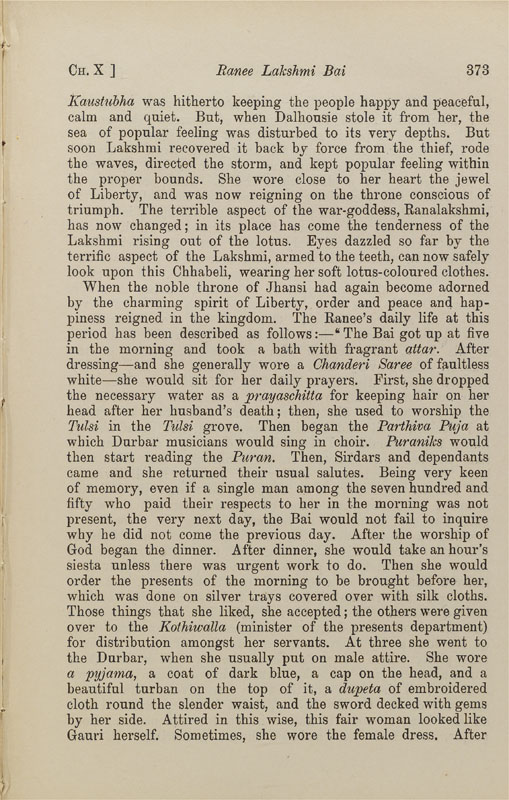Ch.X]
Ranee Lakshmi Bai
373
Kaustubha was hitherto keeping the people happy and peaceful,
calm and quiet. But, when Dalhousie stole it from her, the
sea of popular feeling was disturbed to its very depths. But
soon Lakshmi recovered it back by force from the thief, rode
the waves, directed the storm, and kept popular feeling within
the proper bounds. She wore close to her heart the jewel
of Liberty, and was now reigning on the throne conscious of
triumph. The terrible aspect of the war-goddess, Ranalakshmi,
has now changed; in its place has come the tenderness of the
Lakshmi rising out of the lotus. Eyes dazzled so far by the
terrific aspect of the Lakshmi, armed to the teeth, can now safely
look upon this Chhabeli, wearing her soft lotus-coloured clothes.
When the noble throne of Jhansi had again become adorned
by the charming spirit of Liberty, order and peace and hap¬
piness reigned in the kingdom. The Ranee's daily life at this
period has been described as follows:—* The Bai got up at five
in the morning and took a bath with fragrant attar. After
dressing—and she generally wore a Chanderi Saree of faultless
white—she would sit for her daily prayers. First, she dropped
the necessary water as a prayaschitta for keeping hair on her
head after her husband's death; then, she used to worship the
Tulsi in the Tulsi grove. Then began the Parthiva Puja at
which Durbar musicians would sing in choir. Puraniks would
then start reading the Puran. Then, Sirdars and dependants
came and she returned their usual salutes. Being very keen
of memory, even if a single man among the seven hundred and
fifty who paid their respects to her in the morning was not
present, the very next day, the Bai would not fail to inquire
why he did not come the previous day. After the worship of
God began the dinner. After dinner, she would take an hour's
siesta unless there was urgent work to do. Then she would
order the presents of the morning to be brought before her,
which was done on silver trays covered over with silk cloths.
Those things that she liked, she accepted; the others were given
over to the Kothiwalla (minister of the presents department)
for distribution amongst her servants. At three she went to
the Durbar, when she usually put on male attire. She wore
a pyjama, a coat of dark blue, a cap on the head, and a
beautiful turban on the top of it, a dupeta of embroidered
cloth round the slender waist, and the sword decked with gems
by her side. Attired in this wise, this fair woman looked like
Gauri herself. Sometimes, she wore the female dress. After
|








